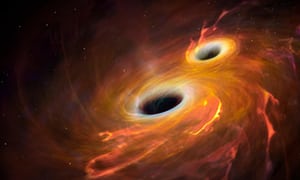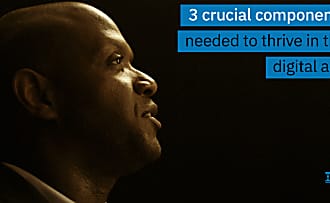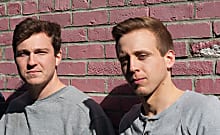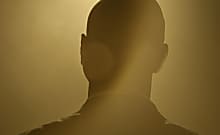Astronomers have made a new detection of gravitational waves and for the first time have been able to trace the shape of ripples sent through spacetime when black holes collide.
The announcement, made at a meeting of the G7 science ministers in Turin, marks the fourth cataclysmic black-hole merger that astronomers have spotted using Ligo, the Laser Interferometer Gravitational-Wave Observatory. The latest detection is the first to have also been picked up by the Virgo detector, located near Pisa, Italy, providing a new layer of detail on the three dimensional pattern of warping that occurs during some of the most violent and energetic events in the universe.
A tiny wobble in the signal, picked up by Ligo’s twin instruments and the Virgo detector on 14 August, could be traced back to the final moments of the merger of two black holes about 1.8bn years ago. The black holes, with masses about 31 and 25 times the mass of the sun, combined to produce a newly spinning black hole with about 53 times the mass of the sun.
Q&A What is a gravitational wave?
Einstein’s general theory of relativity predicts that the presence of mass causes a curvature in spacetime. When massive objects merge, this curvature can be altered, sending ripples out across the universe. These are known as gravitational waves.By the time these disturbances reach us, they are almost imperceptible. It was only a century after Einstein's prediction that scientists developed a detector sensitive enough - the Laser Interferometer Gravitational-Wave Observatory or Ligo - and were able to confirm the existence of gravitational waves.
The remaining three solar masses were converted into pure energy that spilled out as deformations that spread outwards across spacetime like ripples across a pond. Detecting these tiny distortions has required detectors sensitive enough to measuring a discrepancy of just one thousandth of the diameter of an atomic nucleus across a 4km laser beam.
Ligo scientists’ historic observation of gravitational waves
in September 2015, marked the first experimental proof of Einstein’s
prediction a century ago that space itself can be stretched and
squeezed. However, the parallel orientation of the two Ligo detectors,
one in Hanford, Washington state, the other in Livingston, Louisiana,
has meant that scientists are effectively observing one flat plane
through space, rather than getting a 3D picture.
“It’s like if I give you just one slice of apple, you can’t guess what the fruit looks like,” said Prof Andreas Freise, a Ligo project scientist at the University of Birmingham.
This was intentional because it maximised the chances of detection – a discovery that is hotly tipped to be rewarded when the Physics Nobel Prize is announced next week. However, the configuration made it impossible to test a second crucial prediction of Einstein’s theory – the shape of the path that the waves travel along.
Virgo’s arms are angled differently than the two Ligo detectors, allowing astronomers to extract new information about the polarisation of gravitational waves – essentially the path traced out by the vibrations.
“When you see things from different angles, suddenly you can see the 3D shape as well,” he said. “Einstein’s theory of what [the waves] look like is pretty clear.”
Einstein’s theory predicts two polarisations of gravitational waves, but some competing theories of gravity predict up to six.
Prof Stefan Ballmer, a physics professor at Syracuse University, explains: “If you look at how you can bend the sheet of paper that spacetime is, there are many ways you can bend it. But if you look at [Einstein’s predictions], only two of those ways are present.”
The new data – albeit based on a single detection – already appear to strongly favour Einstein’s predictions of how spacetime is expected to crumple.
Combining results from three detectors has also allowed scientists to more accurately triangulate the area of sky from which the waves are emanating. In future, this could allow scientists to swing ground-based telescopes to the target locations to see whether there is any visible trace of the collision itself.
Dr John Veitch, of the University of Glasgow, who co-led a team working on determining the origins and properties of the source, said: “This was a very strong first. Having a third detector means that we can now triangulate the position of the source, and much more accurately determine the exact spot in the cosmos where the signal came from.”
In the case of black holes, theory predicts that there should be no optical signal – but astronomers are open-minded.
“They should be dark ... but black holes are a mystery still to some extent,” said Freise. “We’re only getting signals from them for the first time, the rest is just theory.”
Virgo has been collecting data since 2007, but the instrument was offline undergoing upgrades when Ligo made its first detections of gravitational waves in 2015. The revamped detector was switched on earlier this year, meaning it had a short overlap with Ligo’s observing run, which came to an end in August.
“This is just the beginning of observations with the network enabled by Virgo and Ligo working together,” said Ligo spokesman David Shoemaker of MIT. “With the next observing run planned for [autumn] 2018 we can expect such detections weekly or even more often.”
UK science minister Jo Johnson said: “The latest detection of gravitational waves is an excellent example of international collaboration, which was only made possible due to the breakthrough work undertaken by UK scientists and engineers.”















View all comments >
comments (465)
Sign in or create your Guardian account to join the discussion.
Three solar masses converted into gravitational energy? How?
This is a better video - a computer simlation of a collision slowed down by a factor of 100 and created by the LIGO folk.
https://www.youtube.com/watch?v=XwEH8JQ-4Kw
Thanks for the link. Video much more to the point, and (for me at least) an easier to understand explanation for a challenging topic.
PS: since this topic is about physics, anyone recognize my avatar?
Luis Walter Alvarez one of my science heroes. Think he'd be quite excited about this discovery, and doubtless he'd understand it and it’s implications a far better than the likes of me. ; )
I'm not entirely convinced that the photo at the top of this article is real.
No photo is 'real'.
https://www.wikiart.org/en/rene-magritte/the-treachery-of-images-this-is-not-a-pipe-1948
The photo is real, but it isn't a photo of anything real, though in fact it isn't a photo, it's a jpeg.
No its an artists impression. We have never actually directly observed the accretion disc at the event horizon of a black hole. However just last month the very first image of one (the disc around the event horizon of Saggaterias A the super massive blackhole at the centre of our own Galaxy) was taken using a "virtual" telescope with a virtual light collecting disc in effect the size of the earth. This was done by combining the imaging power of many telescopes. However because of the vast amount of data that needs to be processed to resolve the image it will not be availiable to see for some months yet.
'UK science minister Jo Johnson said: “The latest detection of gravitational waves is an excellent example of international collaboration, which was only made possible due to the breakthrough work undertaken by UK scientists and engineers.” '
I'm sure that European science will grind to a halt after Brexit. (Irony)
LOL. It won't of course; indeed many of us feel that a new freedom to explore will likely emerge. First probably in the UK to combat the present pressures to believe consensus. Consensus in science may in reality bear little or no relation with the truth. Examples abound as in Marshall's idea of the cause of peptic ulcers being heliocobacter pylori. There, consensus nearly got him ostracised and he nearly lost his funding. I look forward to a new science era.
Rather than dedicating immense amounts scarce resources, financial and intellectual, to devising ever new means of killing each other, we should devote them to investigations like that portrayed above....
Henri
What's on the other side of a black hole ?
Klingons? ;-)
????????????????????????????????????????????
Warped space time
If I wanted to be unbelievably pedantic, that first picture is incorrect - remember a black hole is spherical, not flat.
Given that it's perfectly black, would you be able to notice its spherical nature or would it just look like a disc?
No, think about it, a sphere viewed from any angle has the profile of a circle not an ellipse.
As the black holes converge, their event horizons would be elongated into ellipsoids by one another's tidal forces.
A bit of advice Groan...lose the video.
Crap and out of date.
Rachel Sermanni
Nice :)
Yep, nice :)
What happens when two arseholes collide?
In Uranus?
ha ha well done you two for demonstrating empirical evidence !
Shit happens...
Now THAT'S a lucky coincidence. Just happening to catch the dying remnants of a wave emitted just weeks after a star imploded 1.8 billion years ago somewhere in an infinite universe of ever expanding possibility. And I didn't think there could be anything more amazing or full of wonder as when I bumped into an old school friend after 30 years at Dubai airport the other day.
Maybe it happens more often than we are aware of. We've only just started looking for these things. Think of it like a new born baby opening it's eyes for the first time and the photons of light hit it's retina and it tries to make sense of it all. We are at that phase, so it's not really a coincidence. In 20 years time, we may see them all the time, just like we see an "earth-like" planet announced every or day.
You spent 30 years at Dubai airport?
Yep. Poorly planned connection between Heathrow and Sydney.
Just as I thought
What is the point of what "Jo Johnson said"?
What is common contributed by reporting it?
Three solar masses of energy released when the two merged. That is a mind-blowing amount of energy! I assume it was released in a very small amount if time.
Our sun will burn for about 10 Bn years. Now take that 10Bn years of energy*, multiply it by 3 and then release it in an explosion. Wow! That's a loud bang.
For the astrophysicists, what happens to the energy? Some is released as gravitational waves? Some light I assume but that doesn't escape the black hole. Does that light add to the mass of the black hole? And if it does, is the only way the 3 solar masses is lost through gravitational waves? Finally, why can gravitational waves escape the horizon?
*It will burn ~80% of its mass over that time so, for simplicity I assume all the mass is burned in 10Bn years.
Current accepted theory suggests that it is all lost as gravitational waves - this is how the mass/energy is calculated, from the amplitude of the detected waves - but as the article mentions astronomers are keen to get optical telescopes pointed at the location as fast as possible once a source is triangulated to check this out. A mind-boggling amount of energy, but spread over a mind-bogglingly large area: a sphere with a radius of 1.8billion light-years (in fact larger, due to the expansion of the universe).
Thanks for the answer. Very informative!
The Sun will fuse only 0.68% of its mass during all its main sequence life time. So even if the resultant energy were released in 1 instant it would be like comparing striking a match to a hydrogen bomb being exploded
And to think some genuinely believe one advances man & make the world better by voting for Boris Johnson, banning East Europeans, calling Europeans Nazis & listening to Nige while following Treesa.
Poor buggers who think that must live queer crap lives day to day they simply cannot change no matter whom they vote for nor does whatever 'precious' they get hold of do much to change things for them with brains like theirs ;)
THIS is where the future is & they'd literally call it a waste of money that should be spent on bombing someone who lives in a mud hut already.
And they're winning. Oh dear.
What are you babbling on about?
What a warped view of the world you possess - the total intolerance of any other point of view other than your own...........
I think Sucessionoftheplebs must be talking about, Manifesto for conflict resolution.
Time divided by energy = intelligence and the poverty of that in our understanding.
Byefornow
Presence of black holes reveal that universe is just an illusion. I base my argument on the premise that what is not permanent is not real.
... and why would you suggest that what is not permanent is not real?
He read it somewhere and thought it would make him sound clever.
In that case, as nothing is permanent, nothing is real. I knew it! It's all in my head.
Don't watch that video as it'll waste your time
too late : (
As the two black holes approach each other, they orbit each other faster and faster. As they merge, huge amounts of matter are converted to gravitational energy, and the difference in mass is equal to three stars as massive as our sun.
Yes, this much I get, but it's the process I'm trying to grasp. How (or should I be asking why?) does the mass get converted to energy? To lose three solar masses seems downright careless for something that matter's not supposed to escape, let alone two of them.
It’s a consequence of Einstein’s field equations: ‘Spacetime tells matter how to move; matter tells spacetime how to curve.’
Any two things in orbit around each other will radiate energy away in the form of gravitational waves (it takes energy to squeeze and stretch the fabric of space). Ordinarily the amount is so utterly feeble as to be undetectable.
It’s a different matter when two black holes are about to merge, however: two tiny objects each with many times more mass than the Sun spiral around each other thousands of times a second during their final death throes. That’s quite a blur that rips space and time to shreds in the vicinity. Once spacetime has imploded all that is left on the outside is the bending and rippling of space.
Nature is a good accountant and converts energy to different forms all the time. The energy used to bend space is deducted from the final mass of the black hole merger.
Interesting the idea that gravity is subject to change or at least variability in our interpretation or interaction with . It variation is a phenomenon that changes as we travel closer or in relation to black holes it could be that the gravitational waves eminatinf from them affect not just gravity but relativity a perception of time. How we experience time depends on our relationship to gravity. Is it a human or living being phenomenon or is it a truth about velocity and acceleration or rate at which things change relative to our perceptions-- comparing perceptions is impossible and may be constant but only r relationship to gravity is what affects the relativity of our perception of time which is purely a byproduct of our perception of relativity to others over same period but really it's a question of to what set has gravity acted upon us relative to the norm that we are left to perceive
Gravity is essentially just a biproduct of the warping of space time.
What?
This all makes me feel so tiny and insignificant. I guess I am and we all are. Sometimes that fact is unbearable as we have such a short season to exist. I suppose this fact of our mortality is why Religious ideologies exist as to ease that fact and have some semblance of an idea that can claim we are immortal in some sense with absolutely zero proof rendered.
It surely is all hard to understand.
It almost is unbearable isn't it? They say that if you can truly come to terms with the fact that nothing we ever do makes any difference to anything and is ultimately pointless, you reach some Zen enlightenment or something.
Must have been much easier to deal with the complexities of our universe and existence when 25 was considered an old person ! Personally I look forward to more discoveries and endless possibilities !
And I still can't get phone reception in central Edinburgh.
Pity the Sun, Telegraph, Mail etc Readers do not realize that leaving the EU damages co operation on international projects on cutting edge science and physics such as this.
A far greater mystery than the detection of Gravitational waves was the fact that these people, who by there very nature out number those who are very interested in this article were allowed to vote with no safeguards on the direction and funding British Science must take should we leave Europe.
It seems a real pity that Jo Johnson's sibling (fibling?), our unesteemed Foreign Secretary "Lies" Johnson, is doing his best to make international collaboration a thing of the past by being such a knob about Brexit specifically and those dashed foreign Johnnies in general.
I'd be interested in knowing what role U.K. scientists and engineers played in this. Any idea?
Here ya go:
Link 1
Link 2
Good links - thanks. I think the video in Link 2 is far better than the one in this article.
The range of development across the planet is pretty staggering. Some people are fiddling with with outer space and atoms, genes and a whole host of mind-boggling stuff, while others are still living in the mud or just now granting women the right to drive a car. I wonder if this is the most uneven period ever in terms of differences in development.
And the relevance of this here is?
The relevance to me is the vast gap in human development from one place to the next. This is amazing stuff, but we still have people struggling for a decent toilet. Just an observation I suppose.
When Copernicus swept away millennia of false belief and proposed Heliocentrism as the true model of the Solar System people were shitting in pots and throwing it out into the streets. If they were lucky enough to own a pot that is.
Fortunately they didn't halt scientific progress until the pot supply issue was fixed up.
It would be nice if those headings saying 'Gravity waves' are changed to 'Gravitational waves'... A 'gravity wave' is something like the ripples from a pebble dropped into a pond, not at all the same thing as 'gravitational waves' ...
Sign in or create your Guardian account to recommend a comment